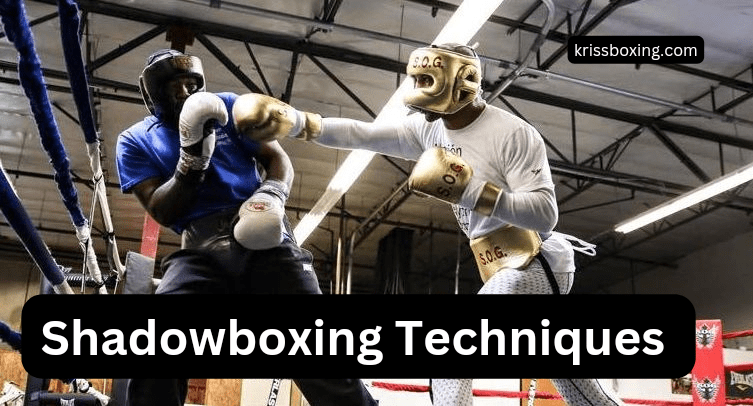Shadowboxing is almost a routine kind of training for anybody who practices boxing. In my opinion, it is one of the most efficient and general approaches to working on matters of techniques, footwork, or even the overall feeling of the ring.
Shadowboxing can be performed anytime and without equipment, making it a staple exercise routine for any fighter, beginner or advanced. This article aims to reveal the 10 handpicked guides to shadowboxing techniques for an effective sparring and fight training.
Integrating Visualization Into Shadowboxing to Improve Fight Readiness
Visualization is used to conjure an opponent’s image and use the mind to act out real fights. This type of training prepares the boxers for what they are likely to encounter during the ongoing bout.
Due to the implementation of movements, punches, and counters, the boxers can think about their strategies in advance as well as enhance their decision-making skills during real sparring sessions or boxing matches.
Thus, this technique not only refines physical fitness but also increases mental activity, which is why shadowboxing is more useful and realistic than the training process.
Top 10 Best Shadowboxing Techniques for Sparring and Fight Preparation in Boxing
1. Basic Punch Combinations
Jab-Cross (1-2)
The jab-cross is basic in boxing and should be a vital part of any fighter’s stance. Shadowboxing with this combination is advantageous because it is a good way of exercising the muscles and fixing the position, speed, and efficiency. Moreover, it is critical to avoid butting the fist into the ribs and ensure that you balance yourself while throwing these punches.
Hook-Cross (3-2)
The hook-cross combination makes your offense diverse and makes it difficult for the opponents to block or predict your moves. Shadowboxing with this combination makes it possible to have ease in the shift between the various punches. Incorporate your hook and your back swing very tightly, and pull through on your crossover.
2. Defensive Movements
Slip and Counter
Shadowboxing is a perfect time to teach slipping punch and retaliation or an excellent time to demonstrate it. In this level the coach wants you to imagine that your opponent’s punches are coming straight for your face, and learn to dodge by moving your head to the side. This is followed up with a rapid strategy to help build the defensive anticipation level.
Roll and Counter
Avoiding incoming blows or slipping away from the striking range is another basic principle of defence. All rolling movements are incorporated while shadowboxing training assists in creating a natural rhythm. Rolls should be used in conjunction with counter punches to enable learners to practice what they would expect when inside the ring.
3. Footwork Drills
Lateral Movement
Another is the fact that there is good footwork in a boxer, and this is an important aspect of boxing. To develop movement side to side try squaring up to your target and shadow boxing where you move from left to right. This drill enhances the chances of dodging a blow and regards the space to establish your angles of aggression.
Pivoting
Converting is a beautiful way of changing course or shifting from one strategy to another in the shortest time possible. Here are some suggestions on how to add a pivoting element to your shadowboxing work to develop better agility and positioning in the ring. Get back, retreat after jabs to mimic evasion of countertop kicks.
4. Combination Variations
1-2-3 (Jab-Cross-Hook)
Punching a basic jab-cross combination involves an additional move, thus making it complex. Recently, I have been practicing the 1-2-3 combination in my shadowboxing to develop multiple punches-relation capacity. Ensure that you keep your body straight, and fall height remains central to the exercise.
2-3-2 (Cross-Hook-Cross)
This combination cogitates the power hand technique. Shadowboxing with the 2-3-2 combination assists in the improvement of the strengths of the punches while making them accurate. Make sure that your feet and your body are also very good at moving around to complement the punches being thrown.
5. Body Shots
Jab to the Body
It has been observed that targeting the body is as effective as going for the head. While shadowboxing, aim your jabs at the body. Bend your knees and reach out with your punch as though targeting the opponent’s stomach area.
Hook to the Body
Hooks to the body will gradually weaken your opponent. Introduce body hooks in your shadowboxing exercises. Concentration should be on a rotation of the hips and the correct position of the guard while throwing the punch.
6. Head Movement
Slip-Jab
Add head movement to offense by practicing the slip-jab. Fake to the side and strike with a jab as soon as possible. This drill assists you in staying defensive responsibly while keeping the pressure on the offense side.
Bob and Weave
The bob and weave is an example of old-school defence. Perform bobbing and weaving movements when performing dummy punches during shadowboxing exercises. This technique makes one escape from punches while at the same time assuming a position to counter.
7. Conditioning Drills
High-Intensity Intervals
Introduce HIIT into the shadowboxing workout regimen. Switch back between highly energetic and rapid striking and low energy and controlled striking. This method imitates a fight and helps to increase the cardiovascular endurance of the athlete.
Shadowboxing with Weights
Using light hand weights is effective in increasing resistance and enhancing the endurance of the shoulder muscles in shadow boxing. The practice assists you in maintaining the desired punch speed and power throughout your fight.
8. Visualization Techniques
Imaginary Opponent
The use of imaginary opponents makes the shadowboxing practice more real. Include in your planning the anticipated moves of your opponent and how you will counter them. It enhances your ring awareness and decision-making since you imagine yourself in the ring.
Fight Scenarios
Engage your minds when shadowboxing by creating specific fight scenarios. For example, imitate the situation when you are on the back foot, in the middle of the ring, or responding to a certain type of opponent. This technique makes you ready according to various scenarios in a real fight.
9. Shadowboxing with a Mirror
Self-Observation
When shadowboxing the use of a mirror is very important as it helps one notice his or her mistakes. Focus on guard, punches, and foot movement. It helps keep a check on your form and inspires you to stay focused and mindful.
Confidence Building
Shadowboxing in front of a mirror also has other advantages such as confidence building. Observing yourself perform techniques effectively enhances desirable conduct styles and confidence.
10. Mindfulness and Breathing
Controlled Breathing
Remember to breathe correctly when shadowboxing. Proper breathing keeps muscles fresh and slows down the level of fatigue. Breathe through your nose and breathe out through your mouth as you sway in time to the music.
Mindful Movement
Savour each detail of your technique as a form of mindful movement. This focus serves to build up your overall proficiency and helps to guarantee that each exertion is calculated and exact.
Frequently Asked Questions (FAQs)
In boxing training, what is the main use of shadow boxing?
Shadowboxing aids in enhancing the technique, footwork, and ring knowledge without using equipment or a partner.
How can I use shadowboxing to enhance my sparring skills?
It also enables you to rehearse combination movements, defence, and footwork to make you sharp when it comes to performing them in the sparring session.
Which combinations should be practiced during shadowboxing?
Some basic movements are the jab-cross (1-2), hook-cross (3-2), and jab-cross-hook (1-2-3) which assist in building rhythm and accuracy.
Is it possible to use shadowboxing to develop defence?
Yes, slipping, rolling, bobbing, and weaving during shadowboxing do enhance your defensive reflexes and your counters.
How to increase the effectiveness of shadowboxing?
Imagine an opponent, using a mirror for self-observation, adding intervals of high intensity, and paying attention to complete breaths and conscious movement.
Conclusion
With shadowboxing training, you can enhance your performance when sparring or in an actual fight. All these top 10 techniques are applicable for strengthening your offense and defence techniques, your footwork, conditioning, and overall mental preparations.
Such practices should be performed frequently to get used to the requirements of the sparring and real combats to improve the overall personality of the boxer.


